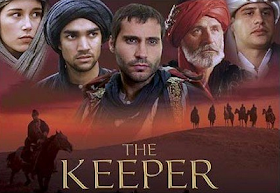 |
| Jerzy Zelnik as Ramses XIII in Jerzy Kawalerowicz's film Pharaoh |
Uzbekistan's majestic monuments, landscapes and walled cities have attracted movie makers for
decades.
In the Soviet era, the government-run Uzbekfilm studio earned a reputation for producing quality patriotic dramas, comedies and even animations, such as
There Will Come Soft Rains based on the Ray Bradbury short story. Today, Uzbekistan produces at least 50 films per year.
Directors from other Soviet republics took advantage of the expertise of Uzbekfilm (founded in 1925) and the wondrous landscapes to shoot many films there. The great director, Tashkent-born Ali Khamrayev (now based in Italy), made many films in his home country.
Here are some foreign movies you may have seen that were filmed in Uzbekistan.
Pharaoh
Jerzy Kawalerowicz's 1966 film Pharaoh was nominated for an Academy Award in 1967 and was also entered in the 1966 Cannes Film Festival.
This epic film took three years produce. Some scenes were shot in Egypt and in the studio. However, mass scenes were filmed mainly in Uzbekistan's part of the Kyzyl Kum
Desert. The crew spent nearly five months there, working in very
difficult conditions - at the height of summer, the noon temperature
exceeded 50C and the temperature of the
sand, 80C. Film stock had to be kept in
cold storage. The ubiquitous desert dust also made filming difficult. Every day,
10,000 bottles of mineral water were delivered to the shooting
location.
 |
| Tilda Swinton starring in Sally Potters' Orlando |
Orlando
Directed by Sally Potter, Orlando is based on Virginia Woolf's novel
Orlando: A Biography. The film starred Tilda Swinton as Orlando, Billy Zane as Marmaduke Bonthrop Shelmerdine, and Quentin Crisp as Queen Elizabeth I.
Potter chose to film much of the Constantinople portion of the book in the remote city of Khiva in western Uzbekistan. She made marvellous use of the forest of carved columns in the city's 18th century Djuma Mosque.
The film premiered at the 1992 Venice International Film Festival.
The Journey to Kafiristan
This 2001 German-language film was directed by Swiss brothers Donatello and Fosco Dubini.
Many scenes were filmed in the ancient Uzbek Silk Road cities of Samarkand, Bukhara and Khiva.
The film is based on Annemarie Schwarzenbach's and Ella Maillart's 1939 road trip to the remote Kafiristan valley in Afghanistan. Schwarzenbach was a Swiss writer and Ella Maillart, a noted athlete, photographer and anthropologist.
The Keeper
 |
Poster from The Keeper, about Omar Khayyam's life and work
|
Omar Khayyam's life and work has inspired many movies, most recently the 2005 film
The Keeper: The Legend of Omar Khayyam, written and directed by US-based Iranian director Kayvan Mashayekh
.
According to director Masjayek, Omar Khayyam personified all the
great qualities of an intelligent man who was able to balance the
concept of reason and faith. Persian history has many such men, but the
combination of a scientific mind and soulful poetry made him an
attractive candidate for a movie
.
The Keeper was filmed almost entirely in Samarkand and Bukhara with an international cast and crew, including Vanessa Redgrave, again in collaboration with Uzbekfilm. The story switches from modern days to the 11th century.
Netaji Subhas Chandra Bose: The Forgotten Hero
This controversial 2004 film is about the
Indian nationalist who, during World War II, tried to rid India of
British rule with the help of Nazi Germany and Japan. The scenes in which Subhas Chandra Bose crossed Afghanistan to meet with the Italian and German governments were filmed in Uzbekistan.
 |
| Poster from Shyam Benegal's Bose: The Forgotten Hero |
The critically acclaimed soundtrack for this movie was composed by two-time Academy Award winner A. R. Rahman.
The songs
Aazadi and
Ekla Chalo were particularly popular. A song
Zikr is composed in the style of Sufi prayer chants.
No Smoking
This is a joint 2007 Indian-Russian psychological thriller written and directed by Anurag Kashyap . The film was shot extensively in parts of the Russian Federation, Kazakhstan, Uzbekistan and Siberia, in extremely cold climates.
The huge-budget film was panned by critics though has garnered a strong cult following among Kashyap fans and movie buffs.
Documentaries
Of course many documentaries have been made about the Silk Road in general and Uzbekistan in particular - a quick YouTube search will yield many results. A recent and noteworthy documentary is a Russian television network's
Uzbekistan: Pearl of the Sands.
Related posts: Khiva's Open-Air Cinema
White Silk Road - Snowboarding Afghanistan
Uzbek Rhapsody: The Films of Ali Khamraev
Uzbekistan: Pearl of the Sands - a New Documentary
Death of Uzbek Film Maker Shukhrat Abbasov








